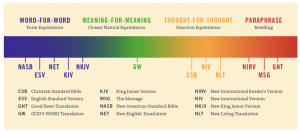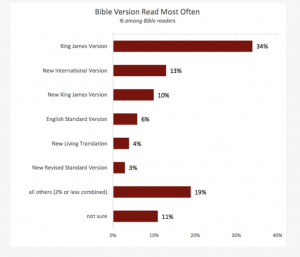Before we can dissect mistranslations of the Bible, we should take a closer look at the process of translation in general. There are three main strategies for biblical translation, all of which facilitate misinterpretations of different types.
Word-for-word attempts to keep the exact words and phrases of the original text, but is sometimes hard to understand because not all aspects of other languages translate to English well.
Thought-for-thought attempts to keep the historical context, but updates the writing style and grammar, leading to a middle ground where the text is more readable but still conveys its antiquity.
Paraphrase translates the ideas from the original text but without being constrained by the traditional grammar, which makes it readable but much less precise because a lot of ancient context is ignored.

These methods exist on a spectrum. Versions like the New American Standard Bible (word-for-word) and Good News Translation (paraphrase) rely mostly on one method, while the New King James Version (word-for-word/meaning-for-meaning) and New International Reader’s Version (thought-for-thought/paraphrase) combine methods more.
We can see the difference between word-for-word and thought-for-thought translations by taking a look at 2 Peter 1:20-21 from the King James Version (word-for-word) and New International Version (thought-for-thought) translations of the text.
King James Version (KJV):
“Knowing this first, that no prophecy of the scripture is of any private interpretation. For the prophecy came not in old time by the will of man: but holy men of God spake as they were moved by the Holy Ghost.”
New International Version (NIV):
“Above all, you must understand that no prophecy of Scripture came about by the prophet’s own interpretation of things. For prophecy never had its origin in the human will, but prophets, though human, spoke from God as they were carried along by the Holy Spirit.”

Thought-for-thought translations, therefore, are much easier people nowadays to read. If we look at the distribution of Bible translations, we can see that the KJV version is the most popular version read. Versions like the NIV deliberately moved away from a literal word-for-word translation so that the Bible would be easier to read.Even though the KJV is harder to understand, a large number of Christians still prefer a literal rendering and to do their own interpreting.
Though most Christians nowadays have the ability to do their own interpreting, up until the 14th century, the Bible was almost exclusively read in Latin. Latin was a language that only educated people spoke, namely the monarchy and the clergy, so the Bible was inaccessible for most western Christians. As a result, many people gained their understanding of the Bible solely from what the Roman Catholic Church said about it.

John Wycliffe—an English theologian from the 14th century—believed that it was necessary to return to the primitive state of the New Testament in order to truly reform the Roman Catholic Church. He set out to translate the Bible into a language that people could understand themselves, English, so they didn’t have to be dependent on the Church’s interpretations. He initiated the first translation of the Bible into the English language and is considered the main precursor of the Protestant Reformation.

Similarly, Jan Hus in Bohemia (now Czech Republic) in the early fifteenth century, believed that social reform could only be achieved through literacy, so he wanted to translate the Bible from Latin to Czech. He, like John Wycliffe, was murdered by the Church authorities for heresy. Even in situations where people tried to interpret scripture for themselves, they were shut out by the group with more social status, especially the clergy. As a result, certain versions of the Bible persisted, while others were drowned out.